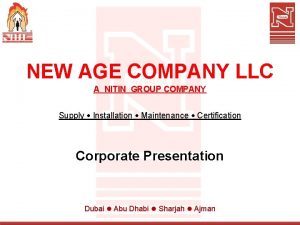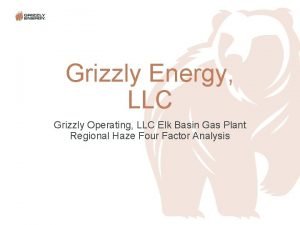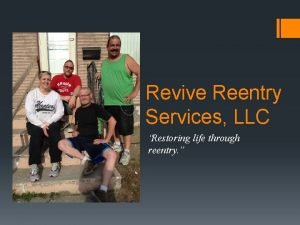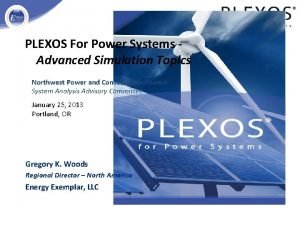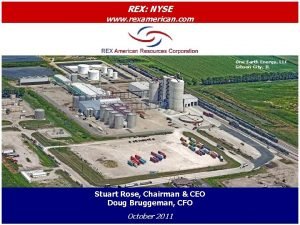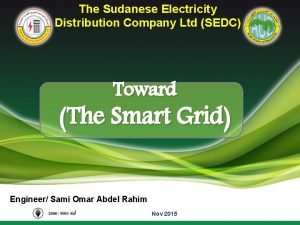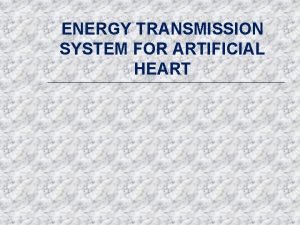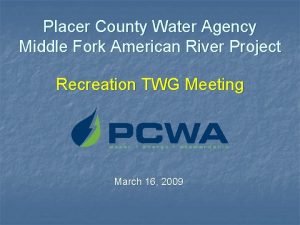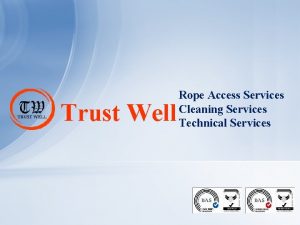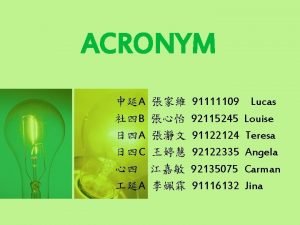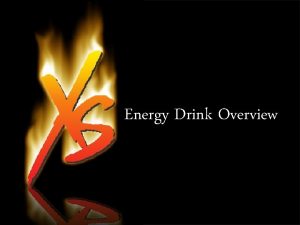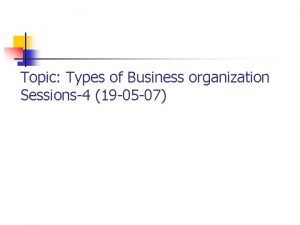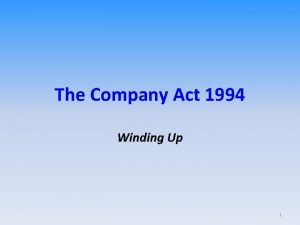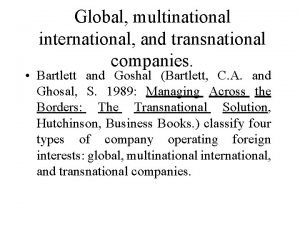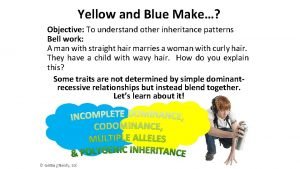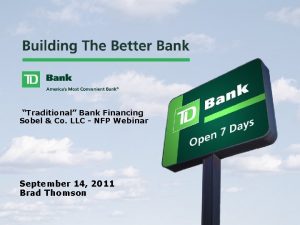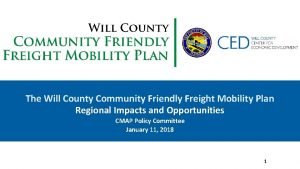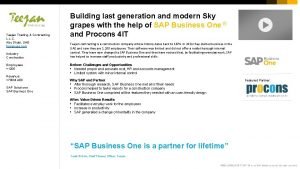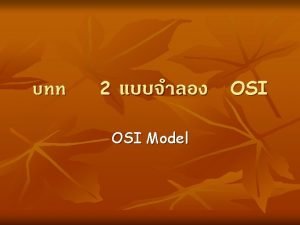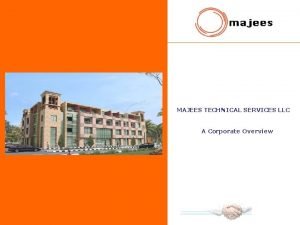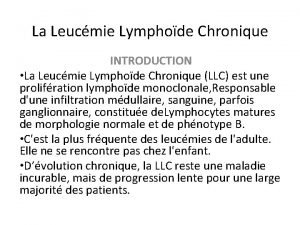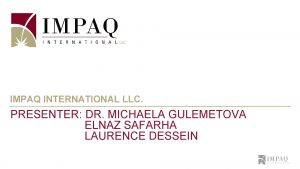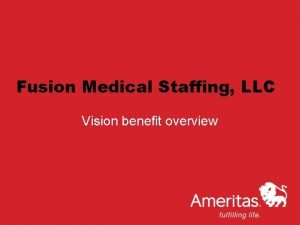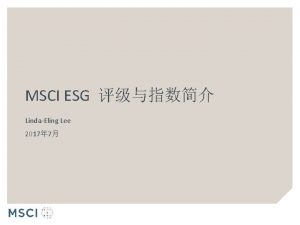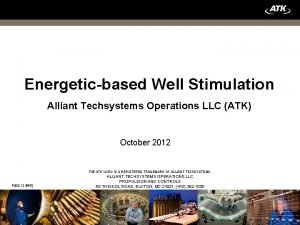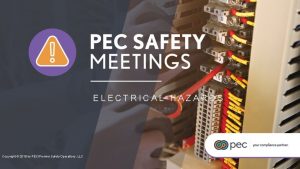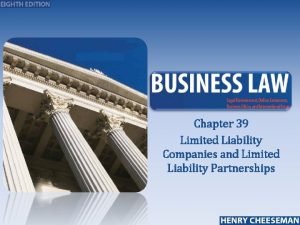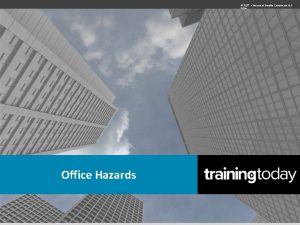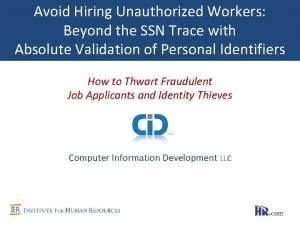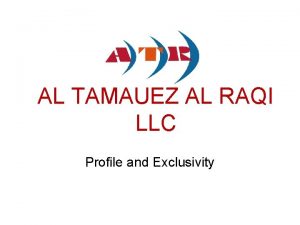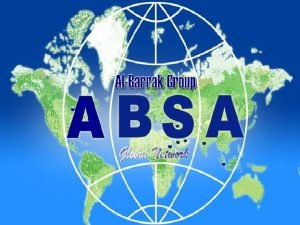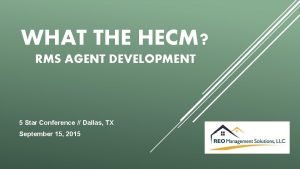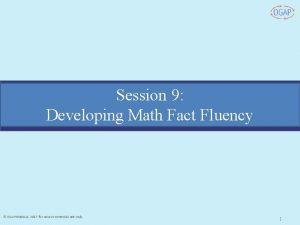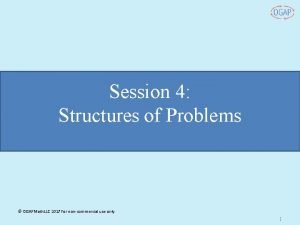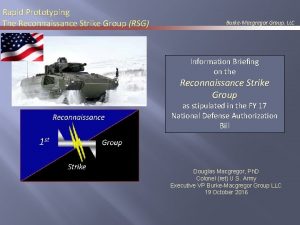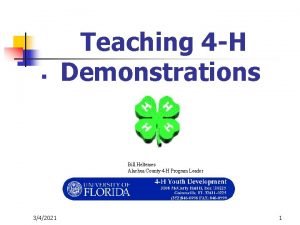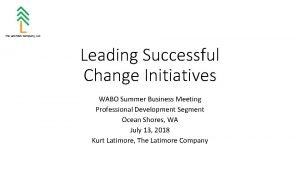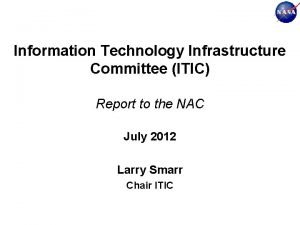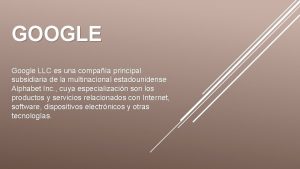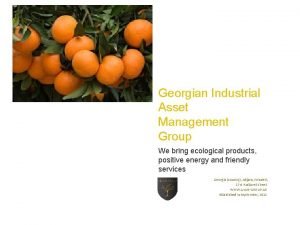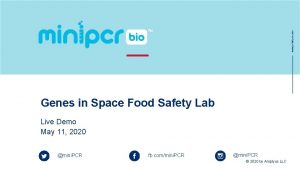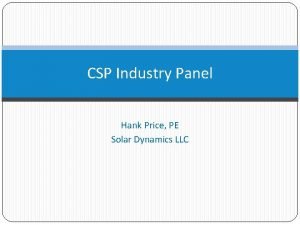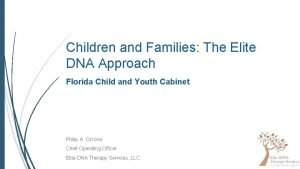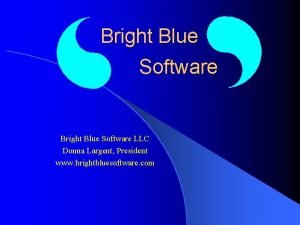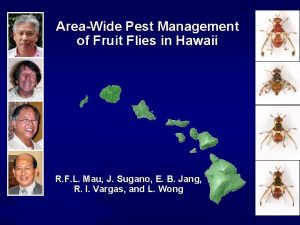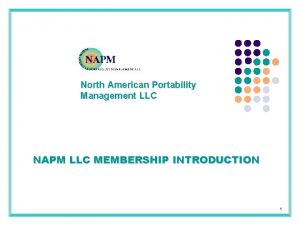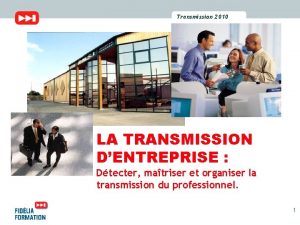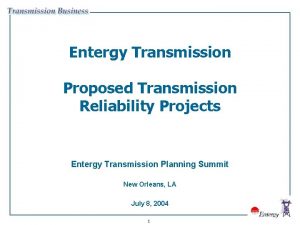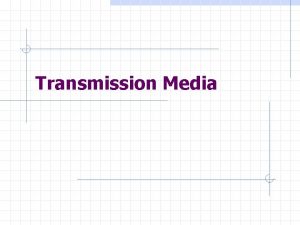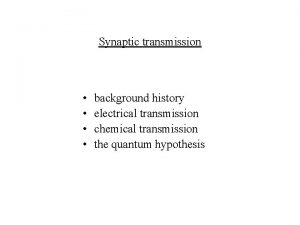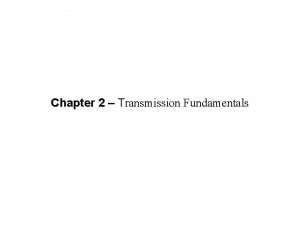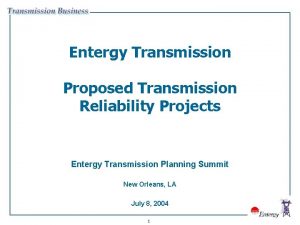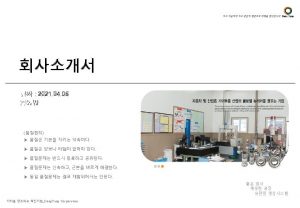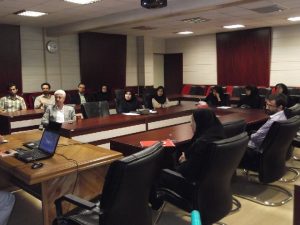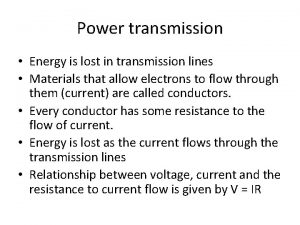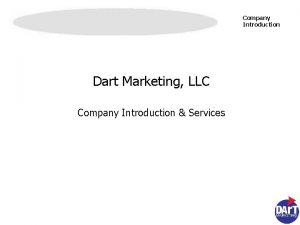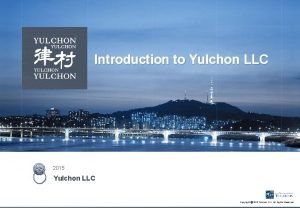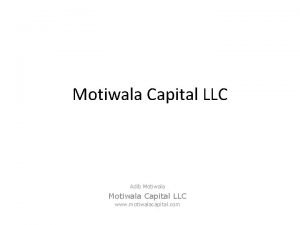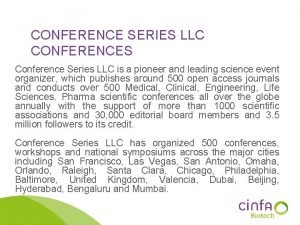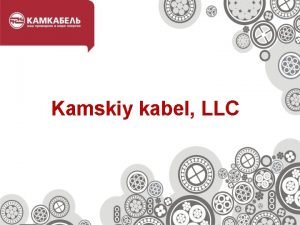American Transmission Company LLC The Energy Access Company
























































































































- Slides: 120

American Transmission Company LLC The Energy Access Company Generation Customer Meeting May 18, 2001 ATC Headquarters Waukesha, Wisconsin 1

Agenda 9: 00 a. m. Welcome Jeff Rauh, Manager of Customer and Regulatory Relations 9: 15 a. m. Cost Allocation Policy and Interconnection Overview Teresa Mogensen, Director of Planning 9: 45 a. m. Interconnection Study Process & Special Studies Dave Cullum, Manager of Stability 11: 00 a. m. Regulatory and Siting Processes Pete Holtz, Siting Project Manager Steve Leovy, Public Service Commission of Wisconsin 11: 45 a. m. Lunch 12: 45 p. m. Interconnection Agreement • Operations Don Morrow, Director of Operations • Engineering & Construction Ken Copp, Director Engineering, Construction and Maintenance • Legal Walt Woelfle, Vice President Legal • Finance Dan Doyle, Vice President & CFO 3: 00 p. m. Transmission Service Requests Transmission Service Dale Burmester, Manager of 3: 15 p. m. MISO/RTO Developments Teresa Mogensen 3: 45 p. m. Wrap-Up and Closing Teresa Mogensen 2

Welcome and Introduction Jeff Rauh Manager Customer and Regulatory Relations 3

ATC Quick Facts • 7 IOUs, 7 municipals and 4 cooperatives divesting transmission assets, 50 k. V and above and associated land rights, into ATC • ATC owns over 7, 500 miles of transmission lines with an approximate book value of $525 million • Construction plans total $80 to $100 million per year in the next four years 4

The ATC System Footprint (Service Areas of Asset Contributors) De Pere Office Waukesha Headquarters Cottage Grove System Operating Center 5

ATC Contributors/Investors • • • • Adams-Columbia Coop (WI) Algoma (WI) Alliant/WPL (WI)* Alliant/South Beloit (IL)* Badger Power (WI) Central Wisconsin Coop (WI) Cloverland Coop (MI) Edison Sault (MI)* Kaukauna (WI) Manitowoc (WI) Marshfield (WI) Menasha (WI) MG&E (WI)* • • • Oconto Falls (WI) Plymouth (WI) Reedsburg (WI) Rock County Coop (WI) Sheboygan Falls (WI) Sturgeon Bay (WI) Sun Prairie (WI) Upper Peninsula Power Co (MI) Wisconsin Electric (WI & MI)* Wisconsin Rapids (WI) Wisconsin Public Power Inc. (WI)* Wisconsin Public Service (WI & MI)* * Contributions closed 1/1/01. Other contributions expected to close by 6/30/01. 6

Directors • José Delgado, CEO American Transmission Company Independent Directors: • Anthony Earl, attorney and former Wisconsin governor, Milwaukee • Agustin Ramirez, CEO Husco International, Waukesha, WI • William Verrette, CEO Champion Inc. , Iron Mountain, MI • Stephen Yanisch, Managing Director, Dain Rauscher Inc. , Minneapolis Representative Directors: • David Porter, Wisconsin Electric • Eliot Protsch, Alliant Energy • Pat Schrickel, Wisconsin Public Service • Roy Thilly, Wisconsin Public Power Inc. • Mark Williamson, Madison Gas and Electric 7

Governance • One director, one vote • Transition to traditional stock-held corporation with owner-elected board after three years • Independent operations from Day One 8

Areas of Focus • Operate Well • Build Necessary Transmission Infrastructure • Create Transmission Service Business 9

Generation Interconnection Cost Allocation Policy Teresa Mogensen Director of Transmission Planning and Service 10

ATC Objectives • Strengthen ATC transmission network • Improve access of ATC customers to competitive energy market – Additional generation interconnections – Impacts on import capability 11

Policy • Include the costs of transmission network facilities associated with generation interconnections in the network costs of the ATC system • Subject to tests: – Network facilities – Reasonableness – Eligibility 12

Network Facilities • Facilities must carry network flow and be judged beneficial to network • Radial generation leads to network interconnection point are not included 13

Example: Interconnecting to an ATC Line Stability SUB D X SU B A SUB B relay ? Miles X SUB C relay ____ Interconnection Facilities (new facilities necessary to interconnect generation) ____ Required Upgrades (breakers, system protection and control) resulting from short circuit and stability studies ____ Subset of Required Upgrades – line addition due to stability ____ Optional Upgrades (thermal and associated upgrade) ____ Existing Facilities 14

Example: Interconnecting to an ATC Substation Line 4 Line 5 Line 3 Line 2 Line 1 ____ Interconnection Facilities (new facilities necessary to interconnect generation) ____ Required Upgrades (breakers, system protection and control) resulting from short circuit and stability studies ____ Subset of Required Upgrades – line addition due to stability ____ Optional Upgrades (thermal and associated upgrade) ____ Existing Facilities 15

Reasonableness Tests • ATC will assess factors including, but not limited to: – Distance from generator to existing ATC system – Application of general least cost planning principles – Point-to-point revenue to annual revenue requirement comparison 16

Eligibility Requirements • Financial screening of generating firm • Guarantee to cover ATC costs expended if project fails or does not proceed as planned • Executed interconnection agreement 17

Policy Subject to Change • Policy may be changed at some time in the future as generation becomes more plentiful, system configuration changes, RTO congestion management systems are implemented or other relevant conditions occur. 18

Overview of Generator Interconnection Process Teresa Mogensen Director of Transmission Planning and Service 19

Multiple Processes Leading to Licensing • Interconnection Study Process is the most visible; however, it is not the only process to consider • In order to be able to produce a regulatory filing after the formed study process is complete, there additional associated processes to follow • Some steps can run in parallel; some must be done in a particular order 20

Multiple Processes • • • Planning Interconnection Studies Detailed Design & Cost Estimating Interconnection Agreement Regulatory Siting Transmission Service 21

Planning Interconnection Studies • Determines impact of proposed new generation or modifications to existing generation on transmission system • Identifies and classifies necessary facilities – Interconnection facilities – Required system upgrades – Optional system upgrades 22

Detailed Design and Cost Estimating • • Standards and Specifications Construction Plans Design Basis Manual for Project Details needed for interconnection agreement and regulatory application 23

Interconnection Agreement • Formalization of relationships and responsibilities – Physical interconnection details – Construction schedules – Ongoing operations – Legal obligations and responsibilities – Financial commitments and qualifications 24

Regulatory • Application for generation requires associated application for transmission • Specific timelines and milestones – Notice and information – Public meetings – Filing steps 25

Siting • Hand-in-hand with regulatory • Constructablity assessment • Work with public to find the most acceptable routes – Public planning process – Inform and involve local officials and government representatives 26

Transmission Service • Separate process/request/queue than for Interconnection Service • Interconnection Service – Provides rights to physically interconnect to transmission system – No rights to move power • Transmission Service – “Delivery Service” – Provides rights to move power 27

Working Together • ATC wants to facilitate successful projects and relationships with our customers • Resolution of backlog is underway • Keep us involved and informed as you initiate and proceed with your project • We want to work together with you for most efficient and effective use of our mutual resources! 28

Interconnection Study Process Dave Cullum Manager of Stability and Special Studies 29

Stability & Special Studies • Current Staff: – Steve Feak, Senior Engineer, since Day 1 – Bob Krueger, Engineer, since April 30 th • Future additions: – Mike Marz, Senior Engineer, May 21 st – Prabhu Gnanam, Engineer, mid-June – One opening still remains 30

Contact Information: • David Cullum – Voice: (608) 877 -7608 – Fax: (608) 877 -7641 – Pager: (608) 681 -2181 – Email: dcullum@atcllc. com – Director: Teresa Mogensen (262) 506 -6860 31

Where Can I Find Information on Generator Interconnections? • Request process is posted on the OASIS • Easiest way to get to this information (including the public queue) – Go to http: //www. atcllc. com/ – Click on “Interconnections” – Click on “Generator Interconnections” • Does not require special access permission 32

The “Queue” • Ordered list of all valid generator interconnection requests received by ATC • Queue order is determined by date and time ATC receives the request • Two versions of the queue: – Confidential, internal – customer’s name and exact siting location – Public – general info, posted to the OASIS 33

The Public “Queue” Queue position is determined by the date the request is received Specifics of the request that are public: • Estimated In-Service Date • Location (State and County) • MW Size and Interconnection Voltage 34

The Public “Queue” • Study status is indicated in the last column • Studies listed as: – “Complete” = final report has been issued – “Interim Report” = a draft report has been issued on some portion of the analysis • Any customer may request a copy of these reports • Reports are written to try to preserve the identity of the customer 35

Who Must Make a Request? • Any new generation wanting to connect to ATC facilities • Any power uprate of existing generation connected to ATC facilities • Customers connecting to a distribution system should make a request to the corresponding Distribution Company 36

Making the Request “How to Get in the Queue” • Download the Generator Interconnection Request form from the OASIS – Available as a PDF or Excel file • Customer must fill in all of the information except those items listed as optional • If all information is not filled in, not a valid request • Not a request for transmission service 37

Request Form 38

Request Form Note: Shaded Boxes are posted on the OASIS 39

Submitting the Request • How can you submit the form: – Fax to phone number on the form – Delivery to address on the form • Receipt of request establishes queue position • Customer must deliver the original, signed form to address on form for the request to be valid, so – If initially faxed, the original form must be received within 10 calendar days of the fax transmittal to retain queue position – If not received within 10 calendar days, receipt of original form will establish a new queue date 40

What Will ATC Do With Request? • Add the request information to the queue • Post the revised public queue within 2 business days • Confirm receipt of original form, when received, with customer and communicate queue position • Begin preparing Study Agreement 41

Before the “Study” • Customer needs to execute a Generator Interconnection Study Agreement • Generic version of agreement is available on the OASIS • ATC will tender the agreement within 30 calendar days of the request • Customer has 15 days to execute 42

The Study Agreement • States what the deliverables are: – Identification of three types facilities related to the requested service • Interconnection Facilities – equipment needed to make the physical connection • Required System Upgrades – equipment needed to resolve stability or short circuit “problems” • Optional System Upgrades – essentially equipment required due to thermal overloads – Cost estimate for these facilities 43

The Study Agreement • States the cost estimate to perform the study and the time frame expected for completion of the study • ATC may revise the cost estimate and time frame as the study progresses • Customer may cancel study at any time • ATC may only charge actual cost of the study incurred up to completion or cancellation 44

The Study Agreement • What does the customer need to supply? – One-line of the proposed interconnection to the transmission system, including a substation diagram showing bus configuration with breaker positions – Generator machine and step-up transformer data plus exciter and governor models • Changes to this information may require a reevaluation of the request • Customer then submits the executed agreement 45

The Study Agreement – Data • Example one-line 46

Changes to a Request • Once a request is made, certain changes will require the customer to submit a new request for interconnection: – Change in generator’s location if it results in a different connection configuration – Earlier in-service date – Significant change in generator’s output – ATC’s engineering judgment 47

The “Study” • Four types of analysis may be required: – Stability – Short circuit – Thermal – Voltage (not typically required) • Data provided is critical for the proper evaluation of interconnection request • Not a Transmission Service Request study 48

The “Study” – Step 1 – Setup • Development of ATC one-line from customer’s submittal • ATC identifies study scenarios • Identification of the Interconnection Facilities can begin – Equipment in black 49

The “Study” – Step 2 – Stability • Stability Analysis – Transient and Dynamic Stability Examined • The system is analyzed with the addition of: – The proposed generation – Any competing request earlier in the queue – Transmission projects with internal approval but do not require a CPCN or acquisition of significant ROW • Output of new units is delivered in the reverse of the CBM directions (75% to CE, 25% to MAPP) 50

The “Study” – Step 2 – Stability • Determine Critical Clearing Time (CCT) for – 3 Phase fault with system intact – 3 Phase fault with prior outage of one element • CCT is the longest time the fault can be applied to the system before unit instability occurs • CCT must be at least 1 cycle longer than the total breaker clearing time to be acceptable – Applies to both the primary and backup clearing scenarios 51

The “Study” – Step 2 – Stability • If find instability, what can be proposed? – Need for high speed circuit breakers and relaying (e. g. , 2 cycle breaker operating time) – Direct tripping of unit(s) – Operating restrictions (e. g. , no operation below 50% system peak load) – Transmission line or transformer additions/changes • Equipment identified in Stability Analysis falls into Required System Upgrades 52

The “Study” – Step 3 – Report • Provide an interim report on the findings from the Stability Analysis • Interim report will include – Interconnection Facilities identified – Required System Upgrades identified – Rough cost estimates of the above equipment – Operating restrictions identified • Notation made on OASIS so other customers may request a copy of this report 53

The “Study” – Step 4 • Two analyses in parallel plus refinement of the initial cost estimates – Short circuit study – Thermal study – not related to transmission service request – Engineering revises the cost estimates for Interconnection Facilities and Required System Upgrades identified in Step 2 54

The “Study” – Short Circuit • The system is analyzed with the following components: – Same system as Stability Analysis plus – Required System Upgrades from Stability • Primarily an issue of circuit breaker overduty – examine before and after • Any equipment identified is listed as a Required System Upgrade 55

The “Study” – Thermal • The system is analyzed with the following components: – Same system as Stability Analysis plus – Required System Upgrades from Stability • Output of new unit is delivered to increasing load within the ATC system • Units in surrounding area are set to maximum output to stress local system 56

The “Study” – Thermal • Only identify transmission elements with a distribution factor 3% – That is, at least 3% of the output of the unit must flow on that particular element – Consistent with MAIN methodology for transmission service requests • Any upgrades identified are Optional System Upgrades 57

The “Study” – Step 5 • Short Circuit analysis is rerun: – Same system as initial Short Circuit plus – Optional System Upgrades • Any equipment identified now is listed as an Optional System Upgrade 58

The “Study” – Step 5 • Stability Analysis may need to be rerun depending on Optional System Upgrades identified • If Stability Analysis must be rerun, more Optional System Upgrades may be identified • Basic message – The study is often an iterative process 59

The “Study” – Step 6 – Final • Conceptual Design is created showing various equipment additions • Engineering produces final cost estimates: – Interconnection Facilities – Required System Upgrades – Optional System Upgrades • First two categories of equipment must be built for interconnection to occur 60

Final Report • Final Report is issued to customer following notation on the OASIS that the study is complete • Other customers may request a copy of the report issued – Good way to find out issues for a particular area of interest 61

Final Report • What will the final report contain? – Summary report of the various analyses – Sub reports as attachments for each analysis • Important points: – If generator data changes as project moves ahead, a re-examination of site may be required – Any operating restrictions will be revisited by ATC as network additions occur 62

Now What? • Final Report is delivered to internal team • Hand-off occurs to Interconnection Agreement Process • Transmission Service Request, if any submitted, will be studied • Billing will occur 63

Consultants • ATC continues to review using consultants to perform studies – Consultant will be paid for by customer – Consultant will coordinate with ATC – Consultant will report results to ATC and ATC will then communicate results using previously described process after posting note on OASIS 64

Helpful Hints • Interconnection Request Transmission Service Request • Make a request that covers the possible unit configurations (e. g. , if up to 5 units, then request a study with those increments) – ATC will determine if the request should be split into different studies and will communicate that to customer – Make separate requests if considering multiple unit types (e. g. , GE 7 FAs vs. GE 7 FBs) – Still need to supply one-line and data for each scenario 65

Helpful Hints • If siting in Wisconsin, go to the Public Service Commission (PSCW) website: – http: //www. psc. state. wi. us/default. htm – OASIS has links to the following PSCW documents: • Requirements for Power Plant and Power Line Development • Electric Power Plants: Approval Process • Construction and Environmental Information Overviews • If siting in Michigan, visit Michigan Public Service Commission (MPSC) website: – http: //www. cis. state. mi. us/mpsc/electric/ • Above links available on the OASIS 66

Helpful Hints • For Wisconsin, Alternate Sites for CPCN: – PSCW requires at least one alternate site – Submit one request to ATC for each of the sites you intend to submit to the PSCW – ATC will determine if more than one study is required – Key issue: electrical equivalence for each part of analysis 67

Helpful Hints • Customers can request study criteria, methodology and base cases – Allows customer to use a consultant to prescreen sites – Provides a common basis to understand the analysis ATC performs – Base cases will not include generation requests in the queue – customer will need to determine what to include from publicly available info 68

Final Comments • Desire feedback from the customer on the study process. ATC wants to know: – What worked and what didn’t – What information was hard to find – What could have been done differently – What information was not clearly communicated – Anything else you think we need to know 69

The Regulatory and Siting Processes Pete Holtz Manager - Siting 70

Interaction With Wisconsin State Agencies • CPCN required for power plants >100 mw and for associated transmission lines • Generation and transmission components should be filed as a single joint application • WDNR must issue construction and operating permits • WDNR air emissions permits required prior to CPCN 71

Project Approval Process • DNR Engineering Plan – 60 days prior to CPCN application • Public Information Meetings – 30 -60 days prior to CPCN application • PSCW Completeness determination – 30 days • Deadline on order issuance – 180 days from completeness determination 72

Regulatory Summary • Contact the PSCW and WDNR and ATC early in a project’s siting process • Establish relationship with agencies and with ATC • Learn how the project approval process works • ATC goal is to work with you to meet regulatory requirements of the project 73

Goal of Siting Process • Connect Point A with Point B • Weigh multiple factors • Balance the Technical with the Feasible 74

Siting Realities • • Takes more time and are more difficult Difficult to obtain 100% acceptance Changing public attitudes Desire for more control and choices Media coverage Easy to organize and obtain information Political responsiveness » 75

Success Includes Recognition • Each Project is unique • Involve of local officials early in the process • Involve public in the process in a structured manner • Continuous communication to all parties • Need for flexibility 76

Siting - Coordination • Internal: Real Estate, Engineering, Environmental, Planning, Construction, Communications and Regulatory areas • External: Public, Government Officials (at all levels), Media, Key Organizations and other identified Stakeholders 77

Public Involvement • Purpose is to provide information, obtain information, respond to concerns and listen • Proactive • Early in the project timeline – prior to formal filings • Involve Public, Government Officials at all levels, key stakeholders, regulators • Many ways to be involved in the planning process 78

Transmission Service Requests (TSRs) Dale Burmester Manager Transmission Services 79

Transmission Service Requests (TSRs) • TSR is required before you can “move” any MWs • All TSRs are made via the OASIS • ATC OASIS node is located at: oasis. maininc. org/OASIS/ATC • Trade. Wave certificate is required to make requests and query offerings, but not to view information • Mid-America Interconnected Network (MAIN) operates the OASIS node, calculates transfer capability and posts ATC/TTC and offerings 80

TSR Tips and Helpful Hints • Point-to-point Transmission Service (PTS) is used to move power off the ATC transmission system • Network Transmission Service (NTS) is used to move power to ATC network customer load – NTS must be requested by the network customer – To prevent “hoarding”, there are special rules for NTS • ATC OASIS Business Practices & Policies: oasis. maininc. org/documents/ATC/practices. html – Converting POD (also POR, source, and /or sink) – Rollover rights 81

TSR Expectations • Requests beyond 13 month posting horizon: 60 days or longer for “System Impact Study” and/or “Facility Study” – Special evaluation is required, since there are no MAIN studies available – At this time, typical study completion dates are projected to be within 60 days. • This can and will change if/when the queue gets larger – TSR study process begins after Generator Interconnection Study is complete • “Optional” upgrades from GIS will likely become required to grant the TSR – All TSRs need to be processed in queue order 82

Recent MISO/RTO Developments Teresa Mogensen Director of Transmission Planning and Service 83

Acronyms • MISO: Midwest Independent System Operator • ARTO: Alliance Regional Transmission Organization • IRCA: Inter RTO Coordination Agreement 84

Midwestern RTO Territories 85

IRCA History • FERC goal for RTO development was to minimize border issues and ultimately create a seamless market • Illinois companies petitioned FERC to leave MISO and join ARTO • With Illinois companies’ departure, resultant Midwestern RTO territories are less than cohesive 86

IRCA History • Settlement negotiations between MISO and ARTO were ordered by FERC to address seams issues and ongoing relationships • Goal was to develop a “super region” such that the two RTOs would look like one to market participants – RTOs decided to work toward common rate and procedures • Result was Inter RTO Coordination Agreement between MISO and ARTO 87

IRCA • 22 issue areas are to be addressed • Plans to address each area must be negotiated between MISO and ARTO and submitted to FERC for approval • Teams of MISO representatives, MISO TO representatives and Alliance representatives are working on each area • Most of the resulting processes must be up and running by end of 2001 88

Joint Generation Interconnection Agreement • IRCA Article 9 mandates development of a “common” interconnection agreement and procedures • Developing interpretation of “common” is “same base principles” rather than “identical” • Allows for differences in business and ownership structures between ARTO and MISO 89

Existing IAs vs. New Ones • If generator had a recently negotiated agreement with an independent transmission company (i. e. ATC) we are working towards being able to “grandfather” the agreement with ARTO/MISO – Plus execute a “bridge agreement” to recognize ISO operating authority • If generator does not have such an agreement reflecting “today’s world”, a new one will need to be negotiated 90

Common IA Development – Key Dates • Updated draft to be issued June 1 • Joint MISO/ARTO Stakeholder meeting in Chicago June 7 thru June 8 • Final version to be issued June 29 91

Opportunities for Input • Watch web sites for announcements of ISO stakeholder meetings or comment opportunities: – http: //www. midwestiso. com/ – http: //www. atcllc. com/ – http: //www. alliancerto. com • Provide your input to ATC or RTO staffs 92

Generation Interconnection – Operating Issues Don Morrow Director of System Operations 93

Operating Issues • • Redispatch Emergencies Data Collection and Communications Metering Operational Control Maintenance Scheduling Process Blackstart 94

Redispatch • What is Redispatch? Ø Generation that needs to be adjusted to ensure the reliable operation of the transmission system. • ATC will redispatch to preserve Network Transmission Service (Attachment K to ATC’s OATT) 95

Redispatch - cont • Section 3. 6 a of GTIA establishes the right of ATC to call on a Generator for Redispatch to maintain Network Security • Section 3. 6 b of GTIA establishes compensation as the incremental cost incurred to perform the redispatch 96

Emergencies • Imminent threat to life or significant threat to health, property or the environment • ATC has right to reduce output or curtail under an emergency • Generator has right to operate interconnection facilities under an emergency 97

Data Collection • Important for the safe and reliable operation of the Transmission System • Instantaneous MW, MVAR, voltage and current • Device status such as breakers, MOD, etc. 98

Data - cont • Generator responsible for the collection and dissemination to the ATC • GTIA allows for this to come from Distributed Control Area Operator 99

Communications • Generator to provide: Ø Voice communications with ATC system operators Ø RTU and data communications of mutually acceptable bandwidth to collect the data from the field 100

Communications - Cont • Data may be distributed to ATC by ICCP or other industry standard protocol • Completed before operation of Generator 101

Metering • Generator owns, operates, tests and maintains Revenue Quality Metering System • Bi-directional Real and Reactive Power • ATC has rights to request meter tests 102

Operational Control Line 4 Line 5 Line 3 Line 2 Line 1 ____ Interconnection Facilities (new facilities necessary to interconnect generation) ____ Required Upgrades (breakers, system protection and control) resulting from short circuit and stability studies ____ Subset of Required Upgrades – line addition due to stability ____ Optional Upgrades (thermal and associated upgrade) ____ Existing Facilities 103

Operational Control - Cont • ATC needs to have operational control over switch regardless of ownership • Concern is something connecting to system without ATC being aware of it 104

Operational Control - Cont • Generator needs to communicate anyway to ensure protection of its equipment • ATC needs to agree to opening and closing the switch • How to ensure? ATC operate? Tag in ATC name? Discuss 105

Maintenance Process • Mutually agreeable maintenance scheduling • Party doing schedule to use good faith to find a mutually acceptable time period • ATC concern is transmission system reliability 106

Maintenance - Cont • Generator to give a rolling 24 month outlook for planned outages • ATC has one month to review and work out alternatives w/ generator if necessary • Applies to units 10 MWs or greater and interconnection facilities 107

Maintenance - Cont • Changes allowed if mutually agreed • Finalization of maintenance schedules is by mutual agreement. • If can’t be agreed upon, ATC has right to set schedule if it feels reliability is in jeopardy. ADR is backstop. 108

Black Start • No requirement for black start in GTIA • Essentially a Network Resource issue since Black Start Capability is addressed in the Network Operating Agreement • ATC needs to ensure sufficient capability to restart the grid. 109

110

Generation Interconnection ATC Engineering Role Ken Copp Director of Engineering 111

ATC Engineering • Output of Planning Study Phase: – Identifies what has to be built to Interconnect – Concept for Design with Cost Estimate – Project Manager assigned to follow project • Engineering Phase: – Kicks off Interconnection Agreement Process – Starts Preliminary Engineering Process • Starts Design Summary Document (part of IA) 112

Design Summary Document, DSD • The DSD is a Scope Summary Document Describing the Facilities to be Built for Interconnection i. e. : – One Line(s) Station and Line – T-line route(s) and type of construction – Stations location and layout 113

Typical Interconnecting Facilities Stability SUB D X SU B A SUB B relay ? Miles X SUB C relay ____ Interconnection Facilities (new facilities necessary to interconnect generation) ____ Required Upgrades (breakers, system protection and control) resulting from short circuit and stability studies ____ Subset of Required Upgrades – line addition due to stability ____ Optional Upgrades (thermal and associated upgrade) ____ Existing Facilities 114

Design Summary Document, DSD • All Facilities should Comply with ATC Design Standards Criteria for: – Stations : bus arrangement, equipment ratings, etc. – T-Lines : easements, structures, conductors – Protection Schemes : Preferred primary and secondary relay packages and communication schemes – (**ATC Design Standard Criteria soon to be available via net ) 115

DSD and Design Basis Manual, DBM • DSD –Design Summary Document – High level scope used in IA – Based on ATC Standards Criteria • DBM – Design Basis Manual – Sufficient Design Detail and Specific Requirements to allow Turn Key Contract for Interconnecting Facilities 116

Design Basis Manual, DBM (follow up to DSD) • DBM – Design Basis Manual –(Includes) – Administrative Procedures – Engineering Studies, Design Calculations – Equipment Quantities, Ratings & Specifications – Quality and Safety Plan – Project Administration – Testing and Commissioning – Final Acceptance 117

Other Interconnection Engineering Activities for ATC & Customer • • • Inform Government Interfaces Assist in route alternative selection Notify Property owners Hold Information meetings Preparation of Engineering Plan (DNR) Ag Impact Statement Prepare CPCN (PSCW) Prepare EA or EIS Real Estate Activities 118

QUESTIONS ? 119

Wrap-Up and Closing Teresa Mogensen Director of Transmission Planning and Service 120
 American transmission company llc
American transmission company llc Caiso transmission access charges
Caiso transmission access charges Nitie fire alarm panel
Nitie fire alarm panel The nielsen company us llc
The nielsen company us llc Grizzly energy llc
Grizzly energy llc 6176503557
6176503557 Grizzly energy, llc
Grizzly energy, llc Plexos api
Plexos api One earth energy
One earth energy Sedc sudan
Sedc sudan Energy energy transfer and general energy analysis
Energy energy transfer and general energy analysis Energy energy transfer and general energy analysis
Energy energy transfer and general energy analysis Energy transmission system for artificial heart
Energy transmission system for artificial heart Terminal access controller access control system
Terminal access controller access control system Terminal access controller access-control system
Terminal access controller access-control system Middle fork american river access
Middle fork american river access Hát kết hợp bộ gõ cơ thể
Hát kết hợp bộ gõ cơ thể Bổ thể
Bổ thể Tỉ lệ cơ thể trẻ em
Tỉ lệ cơ thể trẻ em Gấu đi như thế nào
Gấu đi như thế nào Tư thế worm breton
Tư thế worm breton Chúa yêu trần thế
Chúa yêu trần thế Môn thể thao bắt đầu bằng chữ f
Môn thể thao bắt đầu bằng chữ f Thế nào là hệ số cao nhất
Thế nào là hệ số cao nhất Các châu lục và đại dương trên thế giới
Các châu lục và đại dương trên thế giới Cong thức tính động năng
Cong thức tính động năng Trời xanh đây là của chúng ta thể thơ
Trời xanh đây là của chúng ta thể thơ Cách giải mật thư tọa độ
Cách giải mật thư tọa độ Phép trừ bù
Phép trừ bù Phản ứng thế ankan
Phản ứng thế ankan Các châu lục và đại dương trên thế giới
Các châu lục và đại dương trên thế giới Thơ thất ngôn tứ tuyệt đường luật
Thơ thất ngôn tứ tuyệt đường luật Quá trình desamine hóa có thể tạo ra
Quá trình desamine hóa có thể tạo ra Một số thể thơ truyền thống
Một số thể thơ truyền thống Cái miệng nó xinh thế chỉ nói điều hay thôi
Cái miệng nó xinh thế chỉ nói điều hay thôi Vẽ hình chiếu vuông góc của vật thể sau
Vẽ hình chiếu vuông góc của vật thể sau Thế nào là sự mỏi cơ
Thế nào là sự mỏi cơ đặc điểm cơ thể của người tối cổ
đặc điểm cơ thể của người tối cổ Thế nào là giọng cùng tên?
Thế nào là giọng cùng tên? Vẽ hình chiếu đứng bằng cạnh của vật thể
Vẽ hình chiếu đứng bằng cạnh của vật thể Phối cảnh
Phối cảnh Thẻ vin
Thẻ vin đại từ thay thế
đại từ thay thế điện thế nghỉ
điện thế nghỉ Tư thế ngồi viết
Tư thế ngồi viết Diễn thế sinh thái là
Diễn thế sinh thái là Các loại đột biến cấu trúc nhiễm sắc thể
Các loại đột biến cấu trúc nhiễm sắc thể Bảng số nguyên tố
Bảng số nguyên tố Tư thế ngồi viết
Tư thế ngồi viết Lời thề hippocrates
Lời thề hippocrates Thiếu nhi thế giới liên hoan
Thiếu nhi thế giới liên hoan ưu thế lai là gì
ưu thế lai là gì Khi nào hổ con có thể sống độc lập
Khi nào hổ con có thể sống độc lập Khi nào hổ mẹ dạy hổ con săn mồi
Khi nào hổ mẹ dạy hổ con săn mồi Sơ đồ cơ thể người
Sơ đồ cơ thể người Từ ngữ thể hiện lòng nhân hậu
Từ ngữ thể hiện lòng nhân hậu Thế nào là mạng điện lắp đặt kiểu nổi
Thế nào là mạng điện lắp đặt kiểu nổi Trust well rope access company
Trust well rope access company American broadcasting company
American broadcasting company Energy drink history
Energy drink history Partnership vs limited company
Partnership vs limited company Company act 1994
Company act 1994 Subsidiary and holding company
Subsidiary and holding company Multinational vs international company
Multinational vs international company What type of company was the virginia company?
What type of company was the virginia company? Getting nerdy llc genetics you're such a square answer key
Getting nerdy llc genetics you're such a square answer key Nnemp
Nnemp Sobel & co., llc
Sobel & co., llc Plankey air llc
Plankey air llc Frog scienstructable template
Frog scienstructable template Teejan trading & contracting
Teejan trading & contracting Star feeders
Star feeders Woodfieldpharm steel, llc.usa
Woodfieldpharm steel, llc.usa Characteristics of llc sublayer
Characteristics of llc sublayer Majees technical services llc
Majees technical services llc Critères nci llc
Critères nci llc Impaq international llc
Impaq international llc Huawei tech (uae) fz-llc
Huawei tech (uae) fz-llc Corporate structure for startups
Corporate structure for startups Hewitt associates benefits
Hewitt associates benefits Hector sky
Hector sky Gateway travel agency
Gateway travel agency Fusion medical staffing llc
Fusion medical staffing llc Msci esg research llc
Msci esg research llc Alliant techsystems operations llc
Alliant techsystems operations llc Pecpremier
Pecpremier E & e capital management llc
E & e capital management llc Member managed llc
Member managed llc Llc definition
Llc definition Definition of corporation business
Definition of corporation business Simplify compliance llc
Simplify compliance llc Cpn ssn validator
Cpn ssn validator Purosil distributors
Purosil distributors Al barrak shipping
Al barrak shipping Reverse mortgage solutions reo properties
Reverse mortgage solutions reo properties Speech privacy systems llc
Speech privacy systems llc Ogap math llc
Ogap math llc Ogap math llc
Ogap math llc Onpoint oncology llc
Onpoint oncology llc Burke-macgregor, llc
Burke-macgregor, llc Poseidon water llc
Poseidon water llc Peridot solutions llc
Peridot solutions llc Alachua visuals llc
Alachua visuals llc L llc l l l
L llc l l l Ipost progress llc
Ipost progress llc Piano origen
Piano origen Google llc
Google llc Industrial asset management llc
Industrial asset management llc Amplyus llc
Amplyus llc Wisesorbent technology llc
Wisesorbent technology llc Wlaw llc
Wlaw llc Solar dynamics llc
Solar dynamics llc Avant garde logistics llc
Avant garde logistics llc Elite dna therapy services llc
Elite dna therapy services llc Blue software llc
Blue software llc Frank & delaney immigration law, llc
Frank & delaney immigration law, llc Bg consulting services llc
Bg consulting services llc 1o1 pest control, llc
1o1 pest control, llc Apelles, llc
Apelles, llc Sensobright industries
Sensobright industries


